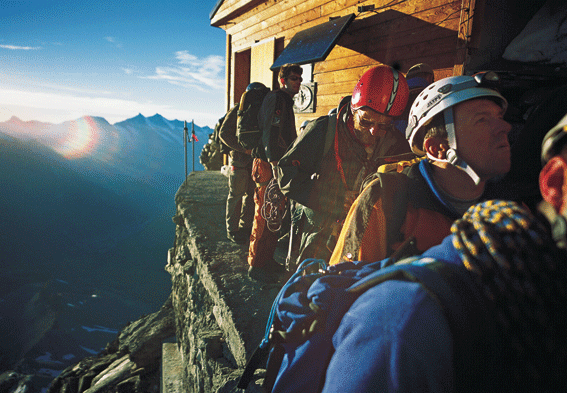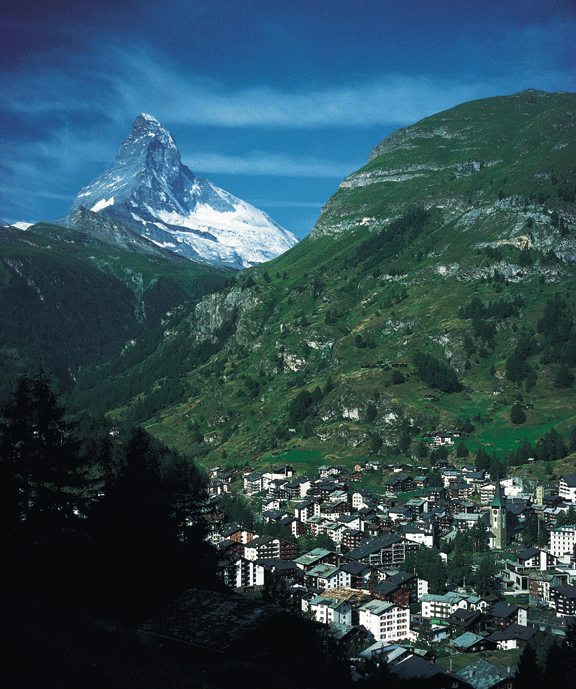
![]() Travel and Adventure
Travel and Adventure
Matterhorn
Triumph and Tragedy on the Matterhorn
Monolithic giants of rock, ice and snow. The Matterhorn has created its own shadow; the jagged ridgeline is sharply outlined against the sky.

By: Bernice Notenboom*
Photo: Dan Westergren
I was just 10 years old when Roni Inderbinen snugged the strap of my helmet and looped his rope through my climbing harness. He knelt down and tied the laces of my boots with double knots so I wouldn’t trip. He turned on my headlamp and rubbed my fingers warm between his strong hands before he slid them into a pair of wool mittens. My father then rechecked everything Roni had just done, securing the helmet and testing the knots.
We set off in the darkness, long before sunrise. We followed the beam of our headlamps to the base of the Swiss route on the Matterhorn. Roni kept a short, tight rope between us all the way to the summit. On top, he reached into his pocket and handed me a piece of dark chocolate shaped like the Matterhorn. I unwrapped it, and he pointed to one side of my chocolate.
“Eat this side first,” he said. “That is the Italian side.”
Thirty years after my first ascent of the Matterhorn, I have come back to Zermatt to climb the Horn – again with Roni Inderbinen.
Much has changed in Zermatt since Edward Whymper, the first climber to scale the Matterhorn, stayed here in 1865. A glance in the hotel’s early guest books reveals descriptions of the initial attempts made by British mountaineers. In fact, the British were the first to climb most of the 38 mountains around Zermatt above 13,000 feet. The 14,692-foot Matterhorn is one of the Alps’ most famous mountains, its rocky, thrusting profile reproduced in countless photographs and souvenirs. For nine months, the mountain is covered with snow, alone and quiet. From late June till September, it attracts climbers from all over the world like bees to a flower.
A train takes you from Tasch to Zermatt, and when it finally comes to a halt, electric taxis and horse-drawn carriages from the fancy hotels are waiting. Travelers silently take in the 180-degree view of the mountains. Overshadowing this vast and impressive semicircle of high Alpine peaks, the Matterhorn stands alone.
It is 3 p.m. on a sunny day when I reach the Hornli Hut, starting point for the climb up the Matterhorn. Monte Rosa, Dent Blanche and Lyskamm – monolithic giants of rock, ice and snow – bathe their faces in the summer sun. The Matterhorn has created its own shadow; the jagged ridgeline is sharply outlined against the sky. The outside terrace of Hornli Hut is crowded with a ragtag assortment of tan, and fit-looking men and women from all over the world. A multicolor jumble of similar-looking backpacks, ropes, and hardware litters the floor. Anxious newcomers sit hunched over guidebooks, seriously studying the route to the top.
I decided to make the hike to Hornli Hut as a warm-up, two days before my celebratory climb of the Matterhorn with Roni.
A helicopter zooms up and hovers above the terrace. Nervous energy circulates among the crowd. Climbers’ expressions become rigid. Looking up, we see the silhouette of a person being lowered from a cable to the edge of a crevass. A stretcher is dispatched down the cable. The beauty of the Matterhorn vanishes, its cold face a chilling stare.
Only about half of the unguided parties reach the summit, and some become local accident statistics. This is only the third week of the Matterhorn climbing season, and already seven people have died.
I walk back to Zermatt. When I arrive, my father is waiting, a worried look on his face. He puts his hand on my shoulder and nods briefly toward the Matterhorn.
“It’s Roni,” he says. “They do not know what happened.” At age 68, Roni Inderbinen – my guide and lifelong friend – is dead, claimed by the mountain he loved.
The Hornli Hut is fully booked tonight, 120 people jammed into rooms and dormitories. Most of us sleep poorly. And there’s the unwelcome thought: Am I right to go ahead with the climb, despite Roni’s death?
I decide that nothing could honor Roni’s memory more fittingly than completing the climb we’d meant to share.
It takes me less than 15 minutes from the wake-up call at 4:30 a.m. to step out of the door. Fifty-five climbing parties will trudge toward the same objective.
Amid the chaos of climbers, my guide, Richard Andenmatten, waits anxiously at the bottom of the stairs. Andenmatten holds the record for the most ascents of the Matterhorn. He stopped counting at 820 times. At age 65, he’s a fourth-generation guide and among the oldest on the mountain. He grabs my harness and clips the loop of his rope in my carabineer, and, without breakfast, we hurry through the back door of the kitchen into the pitch-dark night.
For an hour, we don’t say a word. Andenmatten wants to stay ahead of the caravan of climbers, so we move with unbelievable speed, maneuvering around other parties to get up front. As we make our way upward, he demonstrates where to place each hand and foot.
I keep one eye on the rock and the other on the rope, in which I could become hopelessly entangled if I lose concentration. It is now 6 a.m., and we’ve been climbing for 80 minutes. I am breathless, my throat dry as cotton. My thigh muscles ache. My goal is not to disgrace myself. I feel as if I am 10 years old again, listening in awe to Roni. Andenmatten stops climbing and beckons me, taking in the rope. “Watch,” Andenmatten smiles. “It is the Alpine dawn.”
A panorama of glaciated peaks catches the first sunlight. Within seconds, 29 of Switzerland’s 13,000-foot peaks, ablaze from the sun, poke from pale, misty clouds.
After two hours we pass the Solvay Hut. If you reach this emergency shelter at 13,133 feet in less than three hours, your guide knows that you’re sufficiently fit to continue. Fail, and you head back with no refund.
The route becomes more technical, and the most difficult section lies ahead. Roped tightly to Andenmatten, I stare at the upper Moseley Platte, the crux of the climb, my eyes fixed on the numerous handholds and footholds of its steep face. At the Shoulder – the snowfield before the summit – we take our first break of the day.
“Climbers sometimes question if the guide can hold them, if the rope is secure, and if the rock is strong enough,” he tells me as we put on crampons for the final summit assault. I worry no more than I did when Roni took me up when I was a little girl.
“It was somewhere around here,” Andenmatten says, referring to where Roni fell. We stop for a moment, lost in our own thoughts, before we move on.
We achieve the summit at the same time I normally go to the office. A handshake, a picture and a bite to eat are all we have time for before descending. Briefly, I survey all the peaks I’ve climbed in the Alps since my first ascent of the Matterhorn. A sudden sadness overwhelms me. I miss Roni terribly, yet in my mind’s eye I see him smiling at me in this moment of triumph.
Before I leave Zermatt, I seek out 100-year-old Matterhorn mountaineer Ulrich Inderbinen. As he signs a copy of his biography for me, I ask him for its central message. “Live as you climb mountains,” he tells me, “at a pace that is slow and deliberate but purposeful and regular.” His impressive climbing history supports his theory. He last climbed the Matterhorn when he was 90.
On my final day in town, I went into the village where we had said our farewells to Roni so recently. I walk quietly to the spot where Roni’s coffin had stood. For a minute my thoughts wander back to 30 years ago. My first Matterhorn ascent was celebrated with my father’s promised pint of ice cream. Conquering the Matterhorn had really meant something then. It still does.
Zermatt for the Less Adventurous
Acquaint yourself with old Zermatt at the evocative Alpine Museum, where the history of Swiss village life, mountaineering, and farming are well photographed and documented. The old climbing equipment on display gives you a renewed admiration for the early mountaineers.
From the museum, it’s a short walk to the cemetery where deceased mountaineers over the past century have been buried. They are honored with a climber’s monument nearby.
Just outside Zermatt is the Hotel Schwarzsee, located by an Alpine lake so clear you can photograph the silhouettes of the mountains in the water. You can ride a cable car from the outskirts of Zermatt to the hotel, which sits at an elevation of 8,474 feet, and, while absorbing the high Alpine views, lounge on the sun terrace with homemade Apfelkuchen (apple cake) and coffee.
The Restaurant Findlerhof is a brisk one-hour walk up a hill east of town. From the outside terrace, you look out across the Alpine panorama. Heidi and Franz Schwerz, the owners of the restaurant, serve traditional fare such as rosti (a fried potato cake served with egg and bacon or cheese), and homemade ravioli filled with wild garlic.
A steep two-hour hike leads up to the authentic mountain hostelry Berggasthaus Trift, where you’ll be greeted by Hugo and Fabienne Biner, their three children and one ferocious white cat. Fabienne, a fourth generation owner, inherited the hotel from her parents, and Hugo balances the professions of hotelier and mountain guide.
Many visitors to Zermatt opt for an early morning train ride to the famous Gornergrat Station, with its observatory on a rocky 10,135-foot-high ridge overlooking the Gorner Glacier. From there they can watch the sun rise over the mountains before leisurely walking down to the 7,290-foot Riffelalp plateau for an indulging lunch in the five-star Riffelalp Resort.
The highest cable car in Europe takes passengers to the Klein Matterhorn, from whose peak, at 12,740 feet above sea level, they can see all of the surrounding peaks above 13,000 feet. But the real attraction here is a visit to the Glacier Palace, where you can wander through ice sculptures and formations, wondering how they keep them cool in summer temperatures.
* Bernice Notenboom is a Contributing editor of National Geographic Traveler.